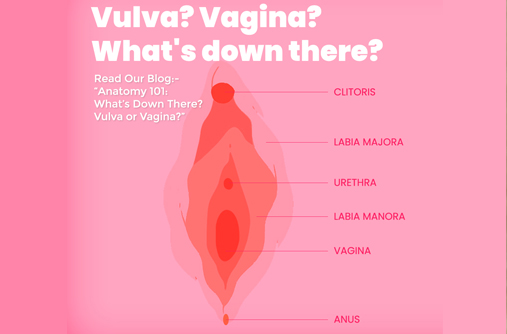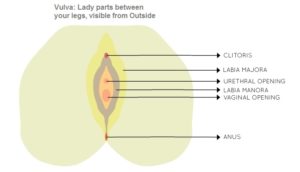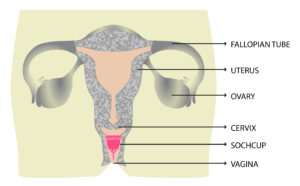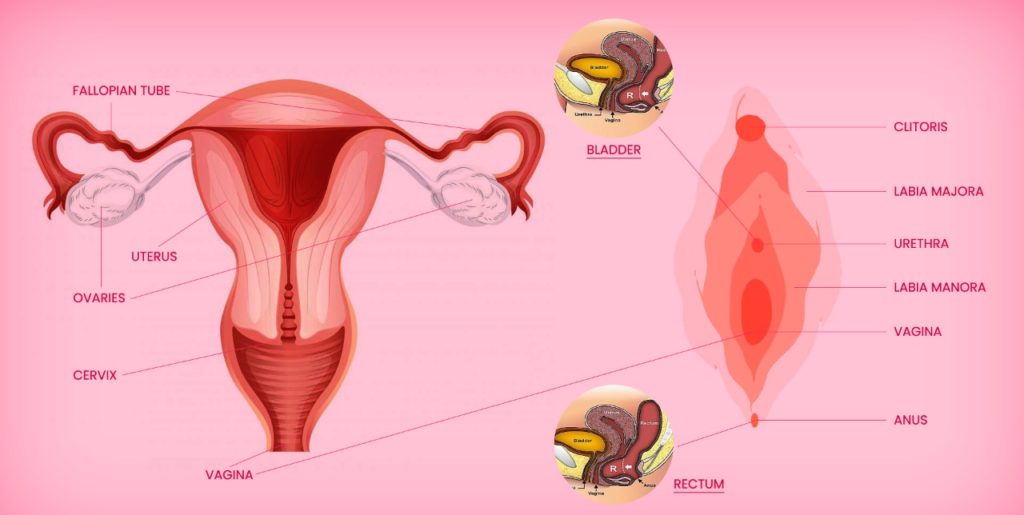Understanding Female Reproductive Organs
The lack of clarity around a female anatomy – whether internal or external – is a problem. We are in the year 2020, yet we see many people confusing the vulva for the vagina, or the vagina for the vulva. This inherent confusion gets multiplied when women start looking into alternative and eco-friendly products for menstrual bleeding. For ex: the use of a menstrual cup or a labia pad (video: what is a labia pad?) requires proper knowledge of both the internal and the external female reproductive anatomy. Therefore, before one takes the big leap and makes the switch to reusable period products, one must know at least the basics.
Diagram of Female Anatomy (External Female Body Parts)
The image above is a diagrammatic representation of the external female reproductive anatomy or – the vulva and the anus. The vulva refers to the outer part of the female genitalia, which includes – the clitoris, the labia, the urethra, and the vagina.
-
- The clitoris is a small, button-shaped organ that is the sole organ in the human body made for experiencing pleasure.
- Below the clitoris is the urethra or the urethral opening, which is where urine exits the body.
- Below the urethra is the vagina, which is the opening for period blood, white discharge, and babies.
- The folds of skin around these three important parts are called the labia – labia majora and labia minora. Labia majora refers to the outer fold of skin, while labia minora refers to the inner fold of skin.
- The anus is located beyond the vaginal opening, and this is where excreta/poop exits the body.
- All in all, there are three openings/holes in the external female reproductive anatomy – urethra, vagina, and anus.
Internal Female Reproductive Organs
Moving on, we’ll take a quick look at the internal female reproductive anatomy – the ovaries, the fallopian tubes, the uterus, and the cervix.
-
-
-
- The ovaries (1 on either side) produce ovum or the egg – this is released once every month and travels through the fallopian tube to the uterus.
- The uterus is where the egg implants, waiting for sperm. If there is sperm (the end result of a male sexual orgasm), the egg meets with the sperm and creates a zygote (which eventually grows into a human baby). While waiting for the sperm, the uterus creates a layer of blood and tissues to house the possible pregnancy. If there is no sperm, this layer breaks down and exits the vagina in the form of period blood.
- The cervix is the end of the uterus; the cervix has to expand in order for period blood/baby to exit the uterus.
-
-
Having explained both the internal and external reproductive anatomies, let us take a look at how the parts on the outside are connected to the internal organs: this is a classic confusion that many women have. Clarifying this confusion helps you understand how to use different period products.
Image: Left – Internal Female Reproductive Organs. Right – External Female Body Parts.
Relationship Between Internal Reproductive Organs and External Body Parts
The image above clearly explains how the urethra on the outside is connected to the bladder on the inside and hence the urinary system. This is the first of the three openings. Next, the vagina on the outside connects to the uterus, ovaries, fallopian tubes, and the ovaries on the inside – the female reproductive system. This is the second of the three openings. Finally, the anus on the outside connects to the rectum on the inside. This is the third of the three openings. With these connections clearly, now it is pretty easy to answer the questions:
-
-
-
- should I take my menstrual cup out when I am peeing?No
- Should I take my menstrual cup out when I am pooping?No.
- Should I put the labia pad inside my vagina?No.
-
-
As someone wise once said, knowledge is power. Learning about the female reproductive system is a big step in being empowered about your own body. It eliminates the shame and confusion around important parts of the body you live in – the body that keeps you going every single day.
We hope this article clarifies all the confusions and doubts you’ve had around the female reproductive anatomy. If you have any more doubts or concerns, please message us on our Facebook or Instagram handles.
To learn about “discussing menstruation with your child,” read our blog: Explain Periods To Your Daughter







